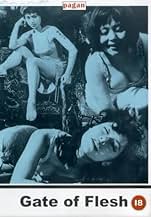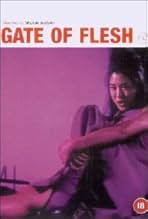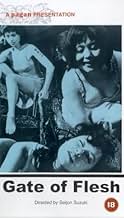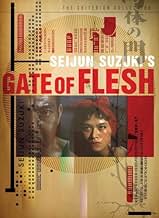IMDb रेटिंग
7.2/10
3.5 हज़ार
आपकी रेटिंग
अपनी भाषा में प्लॉट जोड़ेंAn injured thief on the run finds sanctuary within a brothel of united, ruthless women.An injured thief on the run finds sanctuary within a brothel of united, ruthless women.An injured thief on the run finds sanctuary within a brothel of united, ruthless women.
Jô Shishido
- Shintaro Ibuki
- (as Joe Shishido)
Chico Lourant
- Black Pastor
- (as Chico Roland)
कहानी
क्या आपको पता है
- ट्रिवियाIn an interview Seijun answered the question of the uniqueness of this film in relation to other B/Program pictures he made in the time: "The studio wanted to make a skin flick, that's all. We couldn't make a real porno back then, though."
- गूफ़A downward shot pans across a crowd following a stretcher. When straight down, you see the shadow of the camera, crane and the camera operator.
- कनेक्शनFeatured in From the Ruins: Making 'Gate of Flesh' (2005)
फीचर्ड रिव्यू
I was under the impression when I rented this film that it was
directed by Sezuki Seijun, but the credits gave a different name. It
still might be him (it was something else Sezuki), and I am
assuming it was as I write this review.
Having totally fallen in love with Branded to Kill and, to a slightly
lesser extant, but not too much lesser, with Tokyo Drifter, I was
overjoyed to find this at the video store (I remembered having
heard at one point of its being on video). And I was even more
overjoyed to watch it. It's an amazing film which I would place
slightly ahead of Tokyo Drifter and Branded to Kill, giving it a 9/10.
The film opens right after the end of WWII with a young woman
starving in the street (not something I would expect from the two
previous yakuza films I've seen of Seijun's). She meets up with a
group of four prostitutes who allow her to work with them. They are
self-sufficient and need no pimp. They keep themselves in line
with the threat of torture if any one of them ever sleeps with a man
without accepting money. Of course, you can see the possibility for
exploitation, and there is exploitation, believe me. After a while, a
robust thug (Jo Shishido of Branded to Kill, cheekbones and all)
shows up in their crumbling household. They respect him
because he resists the GIs who try to keep the law in their city
(never specified) and those Japanese people who cooperate with
them. They're also all attracted to him. After this is developed, there
isn't much more plot - only a couple of events happen afterwards.
More or less, it is a character study and also a sociological study.
The anti-Americanism is very interesting to see. Seijun was a
soldier in the Japanese army himself and, although I could easily
point out that, hey, you started it, it's easy to understand what he
must have felt after he and his comrades lost a war, what it would
have done to the male psyche as well as the female (this film was
made about twenty years afterwards).
Some people would naturally hate this film because it mixes its
styles, often very harshly. It's really nothing that Godard wouldn't
have done - in fact, it's actually something that Godard, despite my
great affection for him and his films, could never have achieved; he
was far too interested in subverting filmic conventions and too
unconcerned with making interesting films at times. It is filmed in
color, and its art design/cinematography/costuming, everything
technical, is color coordinated in a way akin to something like a
1950s musical. Four of the five prostitutes are color-coated and
there is, for instance, an amazing scene where these four color- specific hookers muse over Shishido alone against a set
designed only in their colors. Often the film is quite melodramatic,
almost like a Douglas Sirk film. At other times, it is something like
sado-masochistic porno, especially during the torture scenes.
There are scenes akin to the brutality in Tokyo Drifter and Branded
to Kill; there is some major brutality to women (sometimes
inflicted by women), so if you're particularly sensitive to that, you
might want to avoid this. Also, if that's a problem with you, take
special measures to avoid Branded to Kill. You might want to skip
over this next description tot he next paragraph if you very easily get
sick or if you're a militant animal rights activist, but there is a
stunning scene where Jo Shishido slaughters a live cow. I'm pretty
sure it's a real scene of slaughter. If not, then it's a damned good
facsimile. If you were horrified at the real scenes of sacrifice in
Apocalypse Now, you might just want to avoid this film altogether.
The bottom line for me is that this film is a masterpiece. An insane
one, to be sure, but this film, as well as Tokyo Drifter and Branded
to Kill, demonstrate just how gorgeous insanity can be
sometimes. Janus Films, whose logo you see on the videotapes
before just about 90% of all foreign films that were made before
1970, and Home Vision Cinema, who distributes about everything
made after 1970, collaborated on the videotape that I watched,
which recently went out of print. Those two companies should be
ringing tons of bells for anyone who collects videos. Yup, those are
the two companies who produce DVDs' (and Laserdiscs') Criterion Collection, the only DVDs, in the long run, which are really
worth owning. This company has already released both Branded
to Kill and Tokyo Drifter. I pray to God - I'd even sell my soul to the
devil - so that Criterion will release Gate of Flesh and - please,
please God! (or Satan!) - other Seijun films, or even other films
which generally resemble his, if such other artists do exist, that I
have not seen or even heard of. Think about it Criterion. I know that
Branded to Kill and Tokyo Drifter aren't your most popular DVDs,
but, having talked to so many people who are discovering them
and having never resisted an opportunity to spread his name and
reputation to any other film buff I have met (and others who are
familiar with him do the same), I know that he is becoming a huge
cult item. In my mind, judging only by the three films of his that I've
seen, I prefer him even to Akira Kurosawa (I cannot comment on
Ozu or Mizoguchi; unfortunately, I have only ever seen one Ozu and
no Mizoguchis, merely based on availability), whom I generally
prefer to nearly every filmmaker with whom I am very familiar.
directed by Sezuki Seijun, but the credits gave a different name. It
still might be him (it was something else Sezuki), and I am
assuming it was as I write this review.
Having totally fallen in love with Branded to Kill and, to a slightly
lesser extant, but not too much lesser, with Tokyo Drifter, I was
overjoyed to find this at the video store (I remembered having
heard at one point of its being on video). And I was even more
overjoyed to watch it. It's an amazing film which I would place
slightly ahead of Tokyo Drifter and Branded to Kill, giving it a 9/10.
The film opens right after the end of WWII with a young woman
starving in the street (not something I would expect from the two
previous yakuza films I've seen of Seijun's). She meets up with a
group of four prostitutes who allow her to work with them. They are
self-sufficient and need no pimp. They keep themselves in line
with the threat of torture if any one of them ever sleeps with a man
without accepting money. Of course, you can see the possibility for
exploitation, and there is exploitation, believe me. After a while, a
robust thug (Jo Shishido of Branded to Kill, cheekbones and all)
shows up in their crumbling household. They respect him
because he resists the GIs who try to keep the law in their city
(never specified) and those Japanese people who cooperate with
them. They're also all attracted to him. After this is developed, there
isn't much more plot - only a couple of events happen afterwards.
More or less, it is a character study and also a sociological study.
The anti-Americanism is very interesting to see. Seijun was a
soldier in the Japanese army himself and, although I could easily
point out that, hey, you started it, it's easy to understand what he
must have felt after he and his comrades lost a war, what it would
have done to the male psyche as well as the female (this film was
made about twenty years afterwards).
Some people would naturally hate this film because it mixes its
styles, often very harshly. It's really nothing that Godard wouldn't
have done - in fact, it's actually something that Godard, despite my
great affection for him and his films, could never have achieved; he
was far too interested in subverting filmic conventions and too
unconcerned with making interesting films at times. It is filmed in
color, and its art design/cinematography/costuming, everything
technical, is color coordinated in a way akin to something like a
1950s musical. Four of the five prostitutes are color-coated and
there is, for instance, an amazing scene where these four color- specific hookers muse over Shishido alone against a set
designed only in their colors. Often the film is quite melodramatic,
almost like a Douglas Sirk film. At other times, it is something like
sado-masochistic porno, especially during the torture scenes.
There are scenes akin to the brutality in Tokyo Drifter and Branded
to Kill; there is some major brutality to women (sometimes
inflicted by women), so if you're particularly sensitive to that, you
might want to avoid this. Also, if that's a problem with you, take
special measures to avoid Branded to Kill. You might want to skip
over this next description tot he next paragraph if you very easily get
sick or if you're a militant animal rights activist, but there is a
stunning scene where Jo Shishido slaughters a live cow. I'm pretty
sure it's a real scene of slaughter. If not, then it's a damned good
facsimile. If you were horrified at the real scenes of sacrifice in
Apocalypse Now, you might just want to avoid this film altogether.
The bottom line for me is that this film is a masterpiece. An insane
one, to be sure, but this film, as well as Tokyo Drifter and Branded
to Kill, demonstrate just how gorgeous insanity can be
sometimes. Janus Films, whose logo you see on the videotapes
before just about 90% of all foreign films that were made before
1970, and Home Vision Cinema, who distributes about everything
made after 1970, collaborated on the videotape that I watched,
which recently went out of print. Those two companies should be
ringing tons of bells for anyone who collects videos. Yup, those are
the two companies who produce DVDs' (and Laserdiscs') Criterion Collection, the only DVDs, in the long run, which are really
worth owning. This company has already released both Branded
to Kill and Tokyo Drifter. I pray to God - I'd even sell my soul to the
devil - so that Criterion will release Gate of Flesh and - please,
please God! (or Satan!) - other Seijun films, or even other films
which generally resemble his, if such other artists do exist, that I
have not seen or even heard of. Think about it Criterion. I know that
Branded to Kill and Tokyo Drifter aren't your most popular DVDs,
but, having talked to so many people who are discovering them
and having never resisted an opportunity to spread his name and
reputation to any other film buff I have met (and others who are
familiar with him do the same), I know that he is becoming a huge
cult item. In my mind, judging only by the three films of his that I've
seen, I prefer him even to Akira Kurosawa (I cannot comment on
Ozu or Mizoguchi; unfortunately, I have only ever seen one Ozu and
no Mizoguchis, merely based on availability), whom I generally
prefer to nearly every filmmaker with whom I am very familiar.
टॉप पसंद
रेटिंग देने के लिए साइन-इन करें और वैयक्तिकृत सुझावों के लिए वॉचलिस्ट करें
- How long is Gate of Flesh?Alexa द्वारा संचालित
विवरण
- चलने की अवधि1 घंटा 30 मिनट
- ध्वनि मिश्रण
- पक्ष अनुपात
- 2.35 : 1
इस पेज में योगदान दें
किसी बदलाव का सुझाव दें या अनुपलब्ध कॉन्टेंट जोड़ें

























